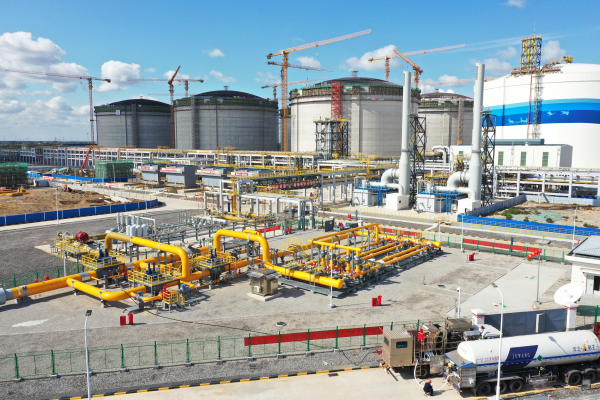As of June 5, China’s west-to-east gas transmission project, operated by China Oil Gas Pipeline Network Corporation (PipeChina), has delivered over 65 billion cubic meters of natural gas to Shanghai and 550 billion cubic meters to the Yangtze River Delta.
This is equivalent to replacing 710 million tons of standard coal and reducing emissions of 804 million tons of carbon dioxide, 13.99 million tons of sulfur dioxide, and 398 million tons of dust — providing strong green momentum for the region’s high-quality development.

A view of a West-East Gas Pipeline station featuring advanced storage tanks and a smart pipeline system [Photo/sasac.gov.cn]
Guided by China’s carbon goals, PipeChina is accelerating the expansion and interconnection of gas pipelines in the Yangtze River Delta, enhancing energy supply and promoting sustainable development.
From a single line to an integrated network
At the Luzhi Station in Suzhou, pipelines from Xinjiang and Central Asia converge and supply gas to Shanghai and Zhejiang. So far this year, the station has delivered 1.2 billion cubic meters — enough to meet the annual gas needs of 7.8 million households.
The West-East Gas Pipeline has evolved from a single pipeline to a regional network, integrating major lines such as the first and second pipelines of the west-to-east gas transmission project, Sichuan-to-east gas transmission pipeline, and Qingdao-Nanjing pipeline. This system now delivers gas in multiple directions — west to east, north to south, and sea to land — ensuring stable and flexible supply.
During the 14th Five-Year Plan period, over 2,200 kilometers of pipelines were added in the region. Another 3,200 km are planned during the 15th Five-Year Plan, further strengthening energy security for the Yangtze River Delta.
Currently, West-East Gas Pipeline supplies gas to 204 end-users in 30 cities across the region, with an average daily volume of over 145 million cubic meters — accounting for about 75 percent of the region’s natural gas consumption.
Smart upgrades for a safer pipeline system
At the Shanghai Baihe Station — the endpoint of West-East Gas Pipeline I — annual transmission has soared from 2 million to over 2 billion cubic meters. The station now uses AR-integrated helmets and digital tools for smart inspections, improving efficiency and safety.
On the pipeline side, traditional manual patrols are being replaced with digital twins, fiber-optic sensors, drone monitoring, and AI systems that detect risks in real time with over 95 percent accuracy. These technologies enable full-view risk monitoring and smart response.
In Shanghai’s central control center, operators monitor over 6,500 km of pipelines and 130 stations in real time. AI models now assist with alarm handling, boosting operational efficiency and response speed.
From energy supply to eco-friendly growth
The Rudong-Haimen-Chongming pipeline brought external gas supply to Chongming Island for the first time, supporting its transformation into a world-class eco-island. It has delivered over 1.6 billion cubic meters of gas to date.
West-East Gas Pipeline is also developing low-carbon demonstration projects. In Haimen, a pressure energy recovery project will soon supply green electricity. In Dingyuan, a waste heat recovery project has generated over 330 million kWh, cutting coal use by 110,000 tons.
West-East Gas Pipeline is also pioneering methane reduction. A new mobile gas recovery system has recovered over 5.4 million cubic meters of gas — equivalent to cutting 70,000 tons of carbon dioxide emissions — further improving environmental and economic outcomes.
(Executive editor: Cui Feng)